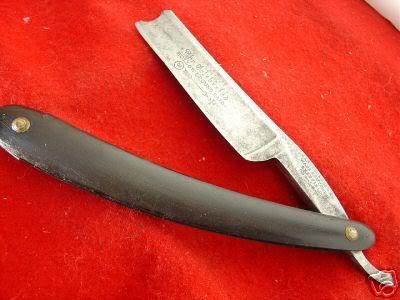Results 1 to 5 of 5
Thread: Ya'll made me do it!
-
03-28-2008, 12:31 AM #1Runs with Badgers

- Join Date
- Mar 2008
- Location
- North Carolina
- Posts
- 28
Thanked: 0 Ya'll made me do it!
Ya'll made me do it!
Well, I just bid and won a W&B. I ended up paying under $40 for it. I think I got away pretty good ... who knows, it could be a major restore job.

The Scales might need some work.

1. What is the general consensus? (shave as is after honing?)
2. How would I go about restoring it? (Would the Maas work?)
3. Who would you recommend to restore it? (I would want to protect the historical integrity as much as possible, e.g. the etching on the blade)
Thanks in advance for help in finding razor #2
-
03-28-2008, 02:39 PM #2

The scales on this model razor are horn. The pins are unique in that they are very large. MAAS will put a shine on the blade but it will not take out the pitting. The razor pictured is one that was in similar shape but it show how nicely they can be restored.

-
03-28-2008, 11:48 PM #3Runs with Badgers

- Join Date
- Mar 2008
- Location
- North Carolina
- Posts
- 28
Thanked: 0
Would removing the pitting involve removing the etching on the blade? I notice that a lot of the W&B blades on this site are mirrors.
/I saw the thread on tumbling the blade ... should I do that?
-
03-29-2008, 01:23 PM #4

If you have a tumbler you can try it. But it will be difficult to match those pins. And you will have to remove the scales to tumble the blade.
To get a mirror finish on a blade it involves sanding and buffing. To preserve etching, I will tape over the etching with painters tape cut to the shape I want to save such as an oval or rectangle or diamond. I will then work around that area. The preserved area gets a cleaning and buffing but not sanding. Many times the etching isn't deep enough to survive even a good buffing so I will sacrifice it for the integrity of the overall appearance. With your blade, it looks to me that etching is deep enough to get it to buff up to match the rest of the blade.
I will often hone a blade first to see if it will take an edge and check the quality of the steel. It's a heart breaker to spend many hours of intense detail work on a blade to only find that it will not hold or even take a shaving edge. The W&B Celebrated Hollow Ground typically is a good blade but I have one on my bench now that does not hold an edge. The older the razor the great likely hood I am going to hone it first. Quality control for 150 year-old steel was an art and not a science. I have honed several razors from that era that are phenomenal shavers but some that are not.
-
The Following User Says Thank You to Kenrup For This Useful Post:
JonC43 (03-30-2008)
-
03-29-2008, 02:56 PM #5Runs with Badgers

- Join Date
- Mar 2008
- Location
- North Carolina
- Posts
- 28
Thanked: 0
Thank you for your advice. I feel that I can get a good grasp on what to do. I never figured that the pins would be so hard to find, or re-manufacture.
I am partially thinking to set up a rig that would hold only the blade in the tumbler, since that is the piece of engraving that I am seeking to preserve most. I don't know how not having the blade moving freely within the tumbler would hurt the efficacy of the cleanup, though.


 LinkBack URL
LinkBack URL About LinkBacks
About LinkBacks






 Reply With Quote
Reply With Quote
